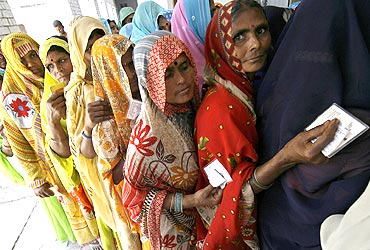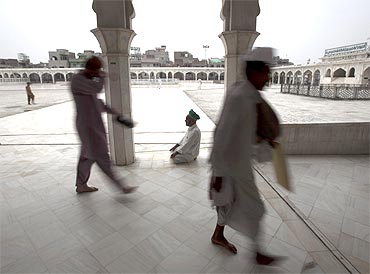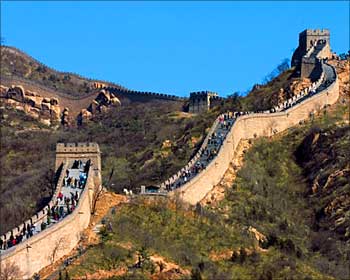BS Reporter in New Delhi
Asian Development Bank on Monday painted two contrasting economic realities of Asia.
While the world's largest and the most populous continent has more than doubled its share in the global gross domestic product from 15 per cent in 1950 to 35 per cent currently, billions of its people do not get even basic amenities of life, the Philippines-based institutions president Haruhiko Kuroda said.
. . .
Two contrasting realities rule Asia, says ADB
Image: Visitors participate in a traditional bean-scattering ceremony at Narita, east of Tokyo.Photographs: Issei Kato/Reuters
Besides, there is a possibility of Asia getting stuck in middle-income group unless reforms are sustained in the continent, he pointed out at a function here to mark 25 years of his 1966-founded bank's economic cooperation with India.
"Many speak of the centre of economic gravity shifting towards Asia, but there are two faces of Asia," he said.
Elaborating, Kuroda said almost two billion Asians live without basic sanitation and nearly half a billion have no access to safe drinking water.
. . .
Two contrasting realities rule Asia, says ADB
Image: Voters wait outside a polling station in Rohania, Uttar PradeshPhotographs: Adnan Abidi/Reuters
"Infant mortality in some countries is over 10 times higher than that in the developed countries. Rising food prices continue to place severe pressure on Asia's poor," he added.
There are widening disparities in incomes, besides an urban-rural divide.
Further, there were changes in demography: some countries age, while the population is growing in others.
Pointing out that rapid economic growth can easily disguise deepening inequality, he said this dualism, if left unattended, could aggravate social, economic and political tensions.
. . .
Two contrasting realities rule Asia, says ADB
Image: A man prays in the courtyard of the Data Darbar Sufi shrine in Lahore.Photographs: Adrees Latif/Reuters
"Emerging Asia must adjust its development strategy to ensure this does not happen," Kuroda said.
He said Asia needs to pursue a development strategy that promotes inclusive growth.
It must devise policies that develop human capital as much as physical improvements. "Most of the region has the fiscal space and private-sector capabilities to create partnerships," Kuroda said.
By utilising these available resources Asia "can narrow" infrastructure gap as well as boost social services such as education, health care, nutrition and sanitation.
. . .
Two contrasting realities rule Asia, says ADB
Image: Chinese currencies.While India, China, most Asian and east Asian countries are growing at rapid pace, high growth has eluded many economies.
"While their economic weight may be small -- around six per cent of Asia's total GDP -- their populations are large.
"Stimulating growth remains a major imperative for these economies," he added.
Pakistan, Sri Lanka Afghanistan, Bangladesh, Bhutan, Lao, Mongolia, Myanmar, Nepal, the Philippines and A host of economies from central Asia and the Pacific region forms part of this group.
. . .
Two contrasting realities rule Asia, says ADB
Image: The Great Wall of China.Photographs: Reuters
While India and China are among those countries experiencing a strong growth, the challenge of sustaining high economic expansion remains over the next 40 years, the chief of the Manila-headquartered ADB said.
Asia is confronted with two scenarios.
While one of them will see Asia grows to account for about half of global GDP by 2050, where per capital income rises to the level of Europe on Monday, the other will see it stuck in the middle income trap with per capita income barely half its potential.
"Policies should focus on strengthening human capital and building an environment conducive to innovation and entrepreneurship," he added.








article